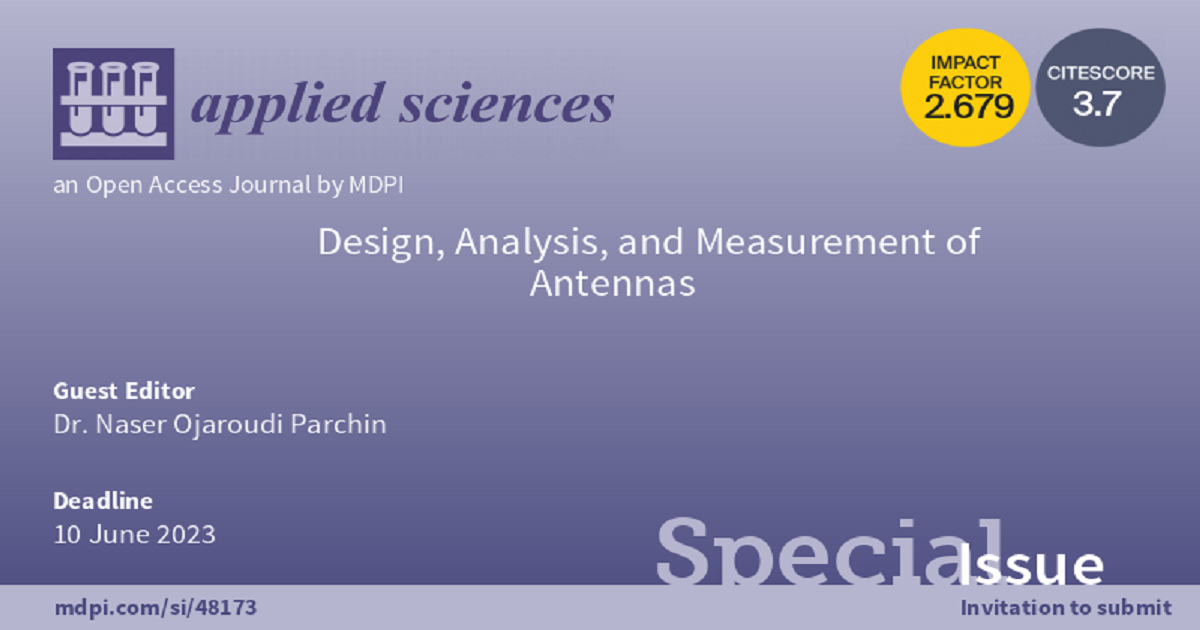Design, Analysis, and Measurement of Antennas
A special issue of Applied Sciences (ISSN 2076-3417). This special issue belongs to the section "Electrical, Electronics and Communications Engineering".
Deadline for manuscript submissions: closed (10 June 2023) | Viewed by 33440

Special Issue Editor
Interests: MIMO/diversity antennas; 5G/6G antennas; MM-wave phased arrays; multi-band/UWB antennas; RFID antennas; metamaterials and metasurfaces; Fabry resonators; fractal antennas; band-pass/band-stop microwave filters; reconfigurable structures; power amplifiers; electromagnetic wave propagation
Special Issues, Collections and Topics in MDPI journals
Special Issue Information
Dear Colleagues,
Rapid growth in the area of modern wireless communication systems has led to the demand for multifunctional devices to be used in various wireless services. Antennas for these devices must be compact, multifunctional, and able to maintain a high level of performance in any kind of environment. One of the important issues in communication systems is the provision of the right orientation between the transmitter and receiver antennas. Circular and dual polarized antennas are good solutions to this problem. Reconfigurable and switchable antennas are attractive in various applications such as cognitive radio, surveillance, and tracking because they produce more than one operation band and radiation pattern using active elements. MIMO technology and phased array systems with multiple adaptive and smart antennas can significantly enhance the capacity of the system and resist multipath fading, and are promising technologies to meet the requirements of the future 5G networks. In a MIMO antenna system with limited space, one of the urgent difficulties to be resolved is to reduce the mutual couplings from adjacent elements. Miniaturization of wireless and handheld devices using miniaturized antennas with metamaterials, EBG, and FSS are necessary nowadays. Low-profile antennas with the low-cost manufacturing and measurement process are desirable for various applications such as RFID, UWB, and WBAN systems.
The objective of this Special Issue is to shed some light on recent advances and novel approaches in design, analysis, and measurement of antennas for various emerging wireless communication systems and identify further avenues for the development of research and techniques in this exciting field.
Submissions can focus on conceptual and applied research in topics including but not limited to the following:
- MIMO and Array Antennas
- UWB Antennas
- Mutual Coupling Reduction
- Antenna Optimization
- Electromagnetic Bandgap (EBG) Structures
- Multiple 5G Antennas
- Antenna Miniaturization
- Mobile Phone and Handheld Antennas
- Filtering Antennas
- Circular and Dual Polarized Antennas
- RFID Antennas
- MM-Wave and THz Antennas
- Adaptive and Smart Antennas
- Metamaterial Antennas
- Fractal Antennas
- Antennas for Biomedical and Wireless Body Area Networks
- Automotive, Radar, and Satellite Antennas
- Reconfigurable and Switchable Antennas
- Prototyping and Manufacturing Methods
- Measurements and Experimentation of Antennas
Submissions should reflect the high quality of this international journal and should not have been submitted or published elsewhere. Extended versions of conference papers that show significant improvement (minimal of over 50%) can be considered for publication in this Special Issue. In addition, we welcome review papers that seek to address the theme of this Special Issue.
Dr. Naser Ojaroudi Parchin
Guest Editor
Manuscript Submission Information
Manuscripts should be submitted online at www.mdpi.com by registering and logging in to this website. Once you are registered, click here to go to the submission form. Manuscripts can be submitted until the deadline. All submissions that pass pre-check are peer-reviewed. Accepted papers will be published continuously in the journal (as soon as accepted) and will be listed together on the special issue website. Research articles, review articles as well as short communications are invited. For planned papers, a title and short abstract (about 100 words) can be sent to the Editorial Office for announcement on this website.
Submitted manuscripts should not have been published previously, nor be under consideration for publication elsewhere (except conference proceedings papers). All manuscripts are thoroughly refereed through a single-blind peer-review process. A guide for authors and other relevant information for submission of manuscripts is available on the Instructions for Authors page. Applied Sciences is an international peer-reviewed open access semimonthly journal published by MDPI.
Please visit the Instructions for Authors page before submitting a manuscript. The Article Processing Charge (APC) for publication in this open access journal is 2400 CHF (Swiss Francs). Submitted papers should be well formatted and use good English. Authors may use MDPI's English editing service prior to publication or during author revisions.
Benefits of Publishing in a Special Issue
- Ease of navigation: Grouping papers by topic helps scholars navigate broad scope journals more efficiently.
- Greater discoverability: Special Issues support the reach and impact of scientific research. Articles in Special Issues are more discoverable and cited more frequently.
- Expansion of research network: Special Issues facilitate connections among authors, fostering scientific collaborations.
- External promotion: Articles in Special Issues are often promoted through the journal's social media, increasing their visibility.
- e-Book format: Special Issues with more than 10 articles can be published as dedicated e-books, ensuring wide and rapid dissemination.
Further information on MDPI's Special Issue polices can be found here.





